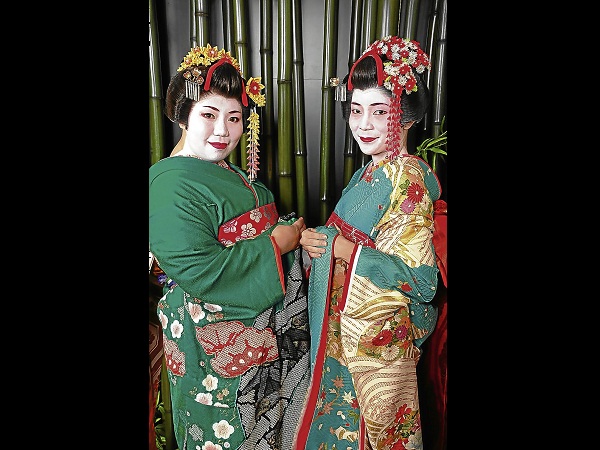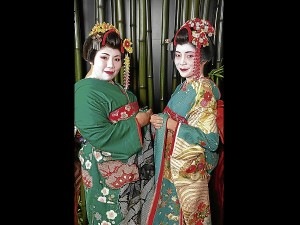
Tottering precariously in my four-inch okobo (wooden platform slippers), I strolled along the streets of Kyoto’s Gion district one drizzly afternoon, leaving a trail of admiring glances from foreigners and locals alike.
I smiled shyly, blushing underneath the thick white makeup—and prayed I wouldn’t trip and fall flat on my perfectly painted face.
As far as appearances went, I was a maiko, an apprentice geisha about to make her debut in Japanese society. But in fact, I was a dolled-up Filipino tourist in a rented wig and kimono who was having the most surreal two hours of her life.
Blame it on years of obsessing with Japanese culture, but I’ve long wondered what it was like to be a woman of the “willow world.” While planning for my Japan trip last November, I came across pictures of foreign tourists dressed up as geisha, including one of a barely recognizable Jessica Simpson in full maiko regalia.
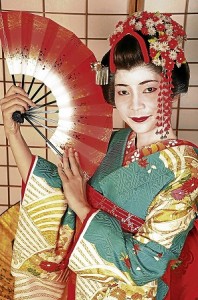
Thoroughly intrigued, I googled studios in Kyoto offering geisha makeover services. Granted, the fees were pretty steep, ranging from 8,000 to 17,000 yen (around P5,000-P10,000) for a few moments in costume, but it was a small price to pay for a girlish fantasy about to come true.
Upon reaching Kyoto, I booked a slot in the charming Yumekoubou studio in Gion, the imperial capital’s famous geisha district. After enticing her with sample photos, I was able to convince my friend and fellow 2bU! alumna Melissa Telan, who works for a law firm in Osaka, to do the “maiko-ver” with me.
A bit of history: A maiko is a teenage geisha-in-training, distinguishable by her colorful kimono with a red collar and tasseled ornaments (kanzashi) in her coiffure. In contrast, a geiko is a full-fledged geisha whose understated elegance is marked by her kimono’s more somber motif and white collar.
Dramatic backdrop
Most tourists choose to dress up as maiko regardless of their age, because the latter’s appearance is usually much more striking (plus, the package is cheaper compared to a geiko’s!). We chose the maiko package that included a short outdoor stroll, as the autumn foliage made for a dramatic backdrop.
Choosing a kimono from the studio’s collection proved to be quite time-consuming for us, since there were so many beautiful designs available. Once done, we changed into thin white inner robes and headed to the makeup station, where the artists applied white rice powder on our face and neck areas.
Because the nape is considered an erogenous zone by the Japanese, a maiko’s collar hangs low at the back with a W-shaped pattern of bare skin to accentuate the area.
Next, our eyelids were lined with a hint of red, brows darkened, and lips rouged. Once the makeup had dried, the artists dressed us in a red-patterned under-kimono before putting on the kimono proper. Mine was a beautiful aqua-and-gold creation with embroidered flowers and red lining, firmly held in place by a fiery crimson sash or darari obi that cascaded down my back.
Finally, they placed a maiko’s heavily ornamented wareshinobu hairstyle over my net-covered head. I was actually relieved to know that we’d be wearing wigs, because there simply wasn’t enough of my sparse, fine hair even for a ponytail. Except for a thin, translucent strip of material along the hairline, one could hardly tell where my forehead ended and the fake hair began.
I wondered how geisha ever put up with having their natural hair regularly waxed and stretched and pulled every which way just so they could sport these impeccable hairstyles every day. I’ve read that most of them developed balding crowns from all that pulling. No pain, no gain.
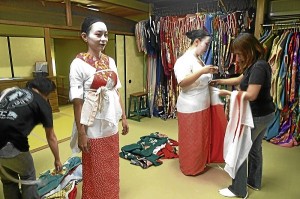
“Okay, all done,” the makeup artist said in Nippongo after a moment, so I thanked her and stood up to look at myself in the full-length mirror for the first time.
My eyes popped open in disbelief. In less than an hour, I was transformed from an ordinary tourist into a living, breathing Japanese work of art, and she completely took my breath away. The goofy grin on her face was the only indication that it was really my own reflection I was staring at.
Mel and I took turns posing for our studio shots, then we were escorted outside for our 10-minute stroll.
After teetering on our okobo for a few seconds on the cobblestone alley, we realized why Japanese ladies took such dainty steps back in the day. But despite our self-conscious wobbling, we were attracting so many curious stares and requests for photo ops that we felt 10 ft tall.
Well, almost.
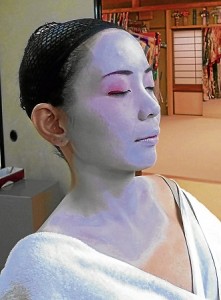
“Do they think we’re the real thing?” I whispered to Mel while graciously posing with passersby. (As it turns out, real geisha usually came out at night and weren’t as eager to do photo ops, so there go my delusions.)
The light drizzle soon turned into fat droplets, which forced us to cut our walk short for fear of ruining our lovely kimono.
Life-changing experience
The whole experience lasted about three hours, from the moment we shed our street clothes down to the painstaking makeup removal, but we loved every minute of it.
We went back to Osaka that day armed with gorgeous photos, wonderful memories, and some pretty interesting observations, one being that many of the customers and photo-happy onlookers were actually locals.
I found it refreshing that these makeover studios serve not just to attract foreigners, but also entice locals to join in on the fun. I guess much of the mystery surrounding geisha still remains, even among their own countrymen.
In between these endless mundane moments of reality, I’m so happy I got to live my dream for a few precious hours. But through the giddy haze, I’ve also developed a newfound sense of respect and admiration for these women of the “willow world.”
Far from being mere courtesans or, heaven forbid, prostitutes, geisha are literally “performing artists,” universally unparalleled in beauty, poise, grace, and talent. Yet for all their femininity, they wield power over their own desires and finances, just like they do over the hearts of men.
Despite the many preconceived notions and controversies surrounding their profession, the geisha embody a time-honored tradition that should never be forgotten.
For me, they’re the earliest surviving symbols of girl power, carving their own strong niche in a strictly patriarchal society that forbade women to live their own lives. And I’m immensely proud to be one of them—physically for a day, but forever in spirit.

